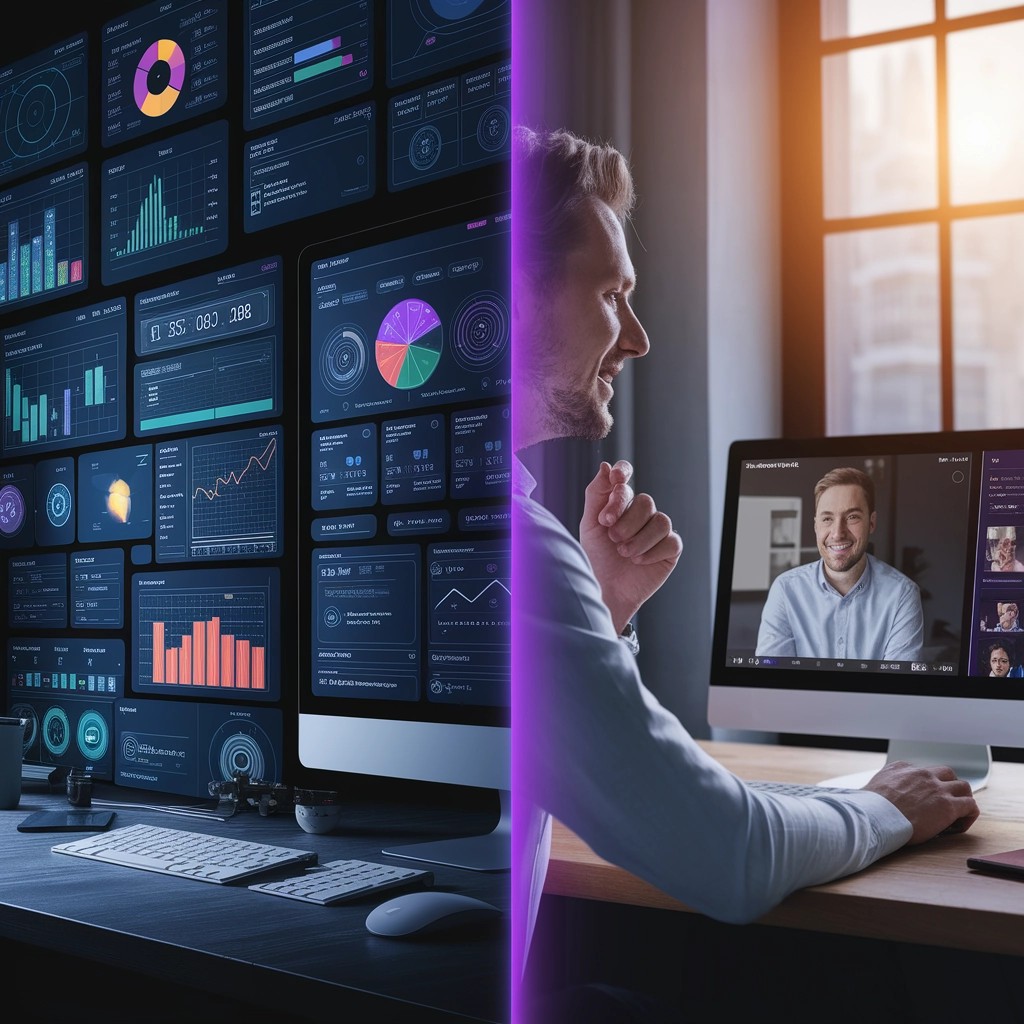The Dawn of a New Collaborative Era
We stand at the threshold of what may be humanity's most transformative partnership. As artificial intelligence evolves from simple automation to sophisticated cognitive assistance, the relationship between humans and machines is fundamentally changing. This isn't about replacement—it's about elevation.
At Level Next Consulting, we're not just observers of this shift; we're active participants in shaping how businesses harness the symbiotic potential of human-AI collaboration. The future we envision isn't one where AI works for us or we work for AI—it's one where we work together, each bringing unique strengths to create outcomes neither could achieve alone.
The Symphony of Complementary Strengths
The most powerful collaborations emerge when different but complementary capabilities unite toward common goals. This fundamental truth is perfectly illustrated in the human-AI relationship.
What AI Brings to the Table
Data Processing at Scale: AI systems can analyze terabytes of information in seconds, identifying patterns invisible to the human eye
Unwavering Consistency: They perform repetitive tasks without fatigue or variation
Prediction Precision: Advanced algorithms can forecast trends and outcomes with remarkable accuracy
Round-the-Clock Operation: AI doesn't sleep, allowing for continuous productivity.
The Irreplaceable Human Element
Emotional Intelligence: The ability to understand nuanced human emotions and respond with empathy.
Creative Innovation: Making intuitive leaps and connections that defy algorithmic logic
Ethical Judgment: Weighing complex moral considerations that extend beyond programmable parameters.
Adaptive Leadership: Navigating ambiguity and making decisions when rules aren't clear
When these capabilities work in harmony, the results are extraordinary. The AI handles the heavy lifting of information processing, freeing humans to focus on interpretation, creativity, and meaningful connection.

Transforming Industries Through Collaborative Intelligence
This partnership is already reshaping how work happens across sectors:
Marketing and Customer Experience
Digital marketing—our specialty at Level Next Consulting—exemplifies the potential of human-AI collaboration. AI-powered analytics tools process vast customer datasets to identify behavioral patterns and preferences. Human marketers then apply creativity and emotional intelligence to craft messaging that resonates authentically with audiences.
Our OmniBoost platform demonstrates this synergy in action. The AI component optimizes campaign performance through data analysis, while our human experts design strategic frameworks and creative content that connect on a human level.
Healthcare
In medical settings, AI assists with diagnostic imaging, scanning thousands of X-rays or MRIs to flag potential issues with remarkable accuracy. Physicians bring clinical judgment, patient relationship skills, and contextual understanding to make final diagnoses and treatment decisions. Together, they're achieving diagnostic accuracy rates that exceed what either could accomplish independently.
Creative Industries
Even in traditionally "human" domains like art and music, collaborative intelligence is opening new frontiers. AI systems generate novel combinations and variations, which human artists then curate, refine, and imbue with emotional depth and cultural relevance.
Financial Services
Financial advisors partner with AI to analyze market trends and portfolio performance while providing the human touch needed to understand clients' life goals, risk tolerance, and emotional relationship with money. This combination delivers both analytical rigor and personalized guidance.
The Emerging Workspace: Neither Fully Human Nor Fully Automated
The future workspace exists in a productive middle ground where humans and AI continuously enhance each other's capabilities. This evolution is happening across three key dimensions:
1. Process Transformation
Workflows are being reimagined from the ground up. Rather than simply automating existing processes, forward-thinking organizations are asking: "How might this entire workflow change if we optimally distribute tasks between humans and AI?"
2. Skill Development
The workforce is developing new capabilities that maximize the collaborative potential:
Prompt engineering: The art of effectively communicating with AI systems
Collaborative judgment: Knowing when to rely on AI recommendations and when to override them
AI literacy: Understanding the capabilities and limitations of AI tools
Augmented creativity: Using AI as a creative partner rather than just a tool
3. Interface Innovation
The points of contact between humans and AI are becoming more intuitive and natural. Voice interfaces, natural language processing, and emerging technologies are creating seamless interaction experiences that feel less like operating technology and more like working with a colleague.

Ethical Guardrails for Responsible Progress
As this partnership evolves, establishing ethical frameworks becomes essential. The future we're building must prioritize:
Transparency
Both AI systems and their human collaborators need visibility into each other's decision-making processes. Black-box AI that can't explain its conclusions undermines trust and accountability.
Shared Responsibility
Clear frameworks must establish who bears responsibility when collaborative decisions lead to negative outcomes. These frameworks should neither place unreasonable burdens on humans nor absolve technology creators of their obligations.
Inclusivity
The benefits of human-AI collaboration must be accessible across diverse populations. This requires addressing algorithmic bias, ensuring equitable access to technology, and designing systems that accommodate different learning styles and abilities.
Human Dignity
Perhaps most importantly, collaborative systems must preserve human agency and dignity. Technologies should enhance human potential rather than diminish it, expanding rather than constraining our choices.
At Level Next Consulting, we believe that responsible AI integration must balance innovation with ethical consideration. The most successful collaborations will be those that elevate our humanity rather than diminish it.
Building Your Human-AI Collaborative Future
Organizations looking to harness the power of human-AI collaboration should consider these foundational steps:
1. Assess Current State
Evaluate existing processes to identify opportunities where AI could complement human capabilities. Look beyond simple automation to areas where AI might enable entirely new approaches.
2. Develop a Collaborative Mindset
Foster a culture that views AI as a partner rather than a replacement. Help team members understand how their roles might evolve to focus on more uniquely human contributions.
3. Start Small, Learn Rapidly
Begin with focused pilot projects that demonstrate the value of collaboration. Use these experiences to develop best practices before scaling more broadly.
4. Invest in Skill Development
Provide training that helps team members develop the skills needed to work effectively with AI systems. This includes both technical capabilities and collaborative approaches.
5. Establish Governance Frameworks
Create clear guidelines for how decisions will be made in collaborative contexts, especially when human judgment and AI recommendations diverge.

The Road Ahead: From Collaboration to Co-Evolution
As we look toward the horizon, the relationship between humans and AI will likely continue to deepen. Today's collaboration may evolve into a more integrated partnership where the boundaries between human and machine intelligence become increasingly fluid.
The most promising vision isn't one where AI simply serves human needs, but where the ongoing interaction between human and artificial intelligence drives mutual growth and development. Just as humans shape AI through our design choices and feedback, AI systems may help us expand our thinking and capabilities in ways we haven't yet imagined.
At Level Next Consulting, we're committed to helping organizations navigate this evolving landscape. We believe that those who master the art of human-AI collaboration won't just optimize their current operations—they'll discover entirely new possibilities for creating value and meaning.
The future belongs not to those who resist this partnership nor to those who surrender to it, but to those who thoughtfully engage with it, shaping it in ways that amplify our shared humanity while harnessing the remarkable capabilities of artificial intelligence.
Together, humans and AI can achieve what neither could accomplish alone: a future of expanded potential, enhanced creativity, and solutions to challenges that once seemed insurmountable. The question isn't whether this partnership will transform our world—it's how we'll guide that transformation to create the future we want to inhabit.
Ready to explore how human-AI collaboration can transform your business? Contact us to begin the conversation.


